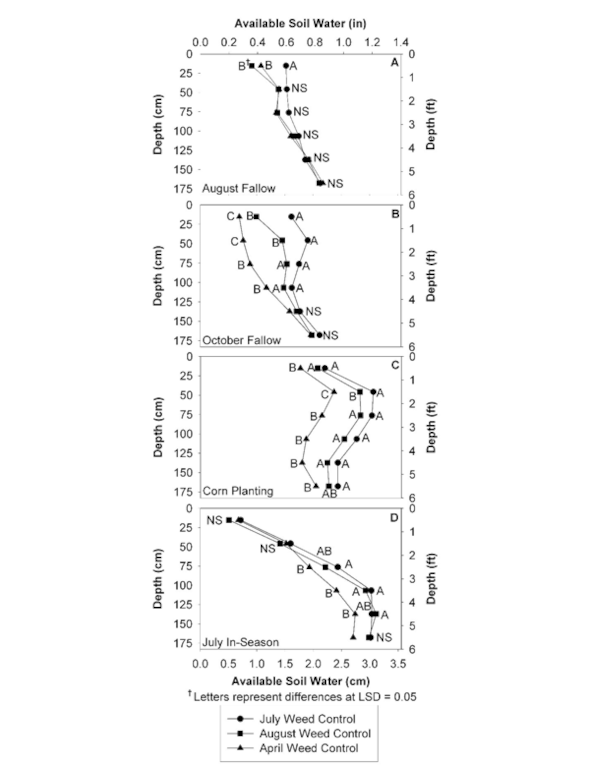By Lucas Haag and Alan Schlegel
In order to maximize the benefits of stubble and no-till dryland cropping systems, weeds must be controlled. A multi-year study was conducted at the Southwest Research-Extension Center at Tribune, Kansas to evaluate the effects of weed control timing after wheat harvest. In this study weeds were terminated after harvest in mid-July and the third week of August.
Timing of post-wheat harvest weed control affected plant-available soil water at the October fallow, corn planting, and July in-season measurements. A numerical trend was evident at the August fallow measurement (Figure 1).
Figure 1. Effect of post-wheat harvest weed control timing on profile available water in a wheat-corn -fallow rotation, Tribune, Kansas.
Depletion of soil water by weeds allowed to grow from July through August was evident at the August sampling, at which the July control treatment had an average of 0.4 in additional soil water. The effect of growing weeds was evidenced by the greatest depletion of soil water occurring from the surface through the 1.5 ft. depth (Figure 2, Panel A). During this time period, the July control treatment had a fallow efficiency of 25.2%, whereas the August and spring control treatments produced efficiencies of 14.7 and 14.6% respectively. Allowing weed growth through October in the spring control treatment resulted in further soil water depletion as evidenced by a profile soil water advantage for the July control of 0.6 in. over the August control and 1.4 in over the spring timing treatment. The difference among weed control timings when measured in October was evident to a depth of 4 ft. (Figure 2, Panel B). Within the August to October fallow period, fallow efficiencies for the July and August control timings were both positive at 19.4 and 16.3%, respectively, whereas the spring treatment with uncontrolled weeds produced a fallow efficiency of -24.0%.

Figure 2. Effect of post-wheat harvest weed control timing on available soil water by depth and time of measurement in a wheat-corn-fallow rotation, Tribune, Kansas.
Weed control timing resulted in available soil water differences at corn planting (Figure 1). At corn planting, the July and August control treatments had 1.6 and 1.1 in., respectively, additional available soil water than when weed control was delayed until the spring. Over the entire wheat harvest to row-crop planting period, fallow accumulations were 3.47, 3.09, and 1.89 in. when weed control was performed in July, August, and spring, respectively. This translated into fallow efficiencies ranging from 30.1% for July control to 16.4% for spring control.
July, August, and spring weed control timings resulted in row-crop grain yields of 51, 47, and 36 bu/ac, respectively, when analyzed across years, Figure 3. Both the July and August treatments produced higher grain yields than the spring treatment.
Figure 3. Effect of post-wheat harvest weed control timing on subsequent corn yields (2004 crop is grain sorghum) in a wheat-corn-fallow rotation, Tribune, Kansas.
In the subsequent corn crop, plant stands were unaffected by weed control timing, whereas the ears per acre yield component declined with delayed weed control, indicating increased barrenness. Spring timing of weed control resulted in the lowest values for water use and water use efficiency. The reduced plant-available water in the spring weed control timing was evident at row-crop planting and this shortfall continued to be present even at the July in-season measurement (Figure 2, Panel D), obviously limiting water use and grain yield potential. By using the differences in plant-available water at planting and grain yields among the treatments in this study, 1 inch of plant-available water was worth an average of 9.4 bu/ac in corn grain yield.
Summary
Delaying weed control in a wheat-corn/sorghum-fallow rotation until spring resulted in soil water depletion that was evident at the first measurement in August. This additional depletion due to weed growth was never recovered, resulting in reduced available soil water at corn/sorghum planting and persisting throughout the growing season. Differences in plant-available water were clearly reflected in grain yields. Delaying weed control resulted in reductions in grain yields, biomass production, water use, and water use efficiency.